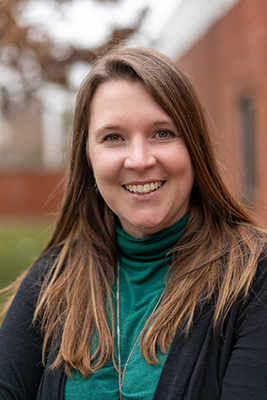Faculty Profile
Jorden Hayes
(she/her/hers)Assistant Professor of Geosciences (2016)Contact Information
Kaufman Hall Room 139
717-254-8303
Bio
Dr. Hayes is a geophysicist and critical zone scientist interested in the transformation of rock at depth into a habitable substrate for life at the surface. She works in the field and lab combining indirect geophysical measurements that image the subsurface with direct measurements of samples from outcrops and boreholes. Jorden is enthusiastic about mentoring students in science and research. Her current projects include the Bedrock Critical Zone Network, GNOMES (Geophysics of the Near-surface: an Outdoor Motivational Experience for Students), and multiple local projects including the Mt. Tabor Cemetery and the Fort Halifax Rediscovery Project.
Education
- B.S., Olivet Nazarene University, 2007
- Ph.D., University of Wyoming, 2016
2023-2024 Academic Year
Fall 2023
FYSM 100 First-Year Seminar
The First-Year Seminar (FYS) introduces students to Dickinson as a "community of inquiry" by developing habits of mind essential to liberal learning. Through the study of a compelling issue or broad topic chosen by their faculty member, students will:
- Critically analyze information and ideas
- Examine issues from multiple perspectives
- Discuss, debate and defend ideas, including one's own views, with clarity and reason
- Develop discernment, facility and ethical responsibility in using information, and
- Create clear academic writing
The small group seminar format of this course promotes discussion and interaction among students and their professor. In addition, the professor serves as students' initial academic advisor. This course does not duplicate in content any other course in the curriculum and may not be used to fulfill any other graduation requirement.
GEOS 141 Earth's Hazards
This course examines natural processes such as earthquakes, volcanic eruptions, mass wasting events, and floods that have the potential to produce disastrous consequences for humans. All of these processes result from interactions between the atmosphere, biosphere, geosphere and hydrosphere directly or indirectly, which is the realm of earth sciences. Increasing global populations and increasingly interdependent national economies mean that few disasters are now only ‘local’. This course will use examples such as case studies of recent earthquakes and volcanic eruptions to examine how natural processes can be hazardous, and whether or not humans can anticipate and mitigate these kinds of hazards to prevent future disasters. Laboratory work will include analog experiments, field trips, and video analysis of historic disasters. Three hours classroom and three hours laboratory a week.
Spring 2024
GEOS 221 Oceanography
An interdisciplinary introduction to the marine environment, including the chemistry of seawater, the physics of currents, water masses and waves, the geology of ocean basins, marine sediments and coastal features, and the biology of marine ecosystems. Topics include the theory of plate tectonics as an explanation for ocean basins, mid-ocean ridges, trenches, and island arcs. The interaction of man as exploiter and polluter in the marine environment is also considered.
Three hours classroom and three hours laboratory per week. Prerequisite: One introductory lab science or permission of instructor. Offered every other year.
